 | –≠–ª–µ–∫—Ç—Ä–æ–Ω–Ω—ã–π –∫–æ–º–ø–æ–Ω–µ–Ω—Ç: UCC27323P | –°–∫–∞—á–∞—Ç—å:  PDF PDF  ZIP ZIP |
Document Outline
- FEATURES
- APPLICATIONS
- DESCRIPTION
- BLOCK DIAGRAM
- ORDERING INFORMATION
- power dissipation rating table
- absolute maximum ratings over operating free-air temperature (unless ot\
herwise noted)
- electrical characteristics, V DD = 4.5 V to 15 V, T A = T J , (unless o\
therwise noted)
- input (INA, INB)
- output (OUTA, OUTB)
- switching time
- overall
- Terminal Functions
- APPLICATION INFORMATION
- general information
- input stage
- output stage
- source/sink capabilities during Miller plateau
- parallel outputs
- operational waveforms and circuit layout
- VDD
- drive current and power requirements
- THERMAL INFORMATION
- MECHANICAL DATA
- D (R-PDSO-G**) PLASTIC SMALL-OUTLINE PACKAGE
- DGN (MSOP) PowerPAD PLASTIC SMALL-OUTLINE PACKAGE
- P (PDIP) PLASTIC DUAL-IN-LINE
- IMPORTANT NOTICE
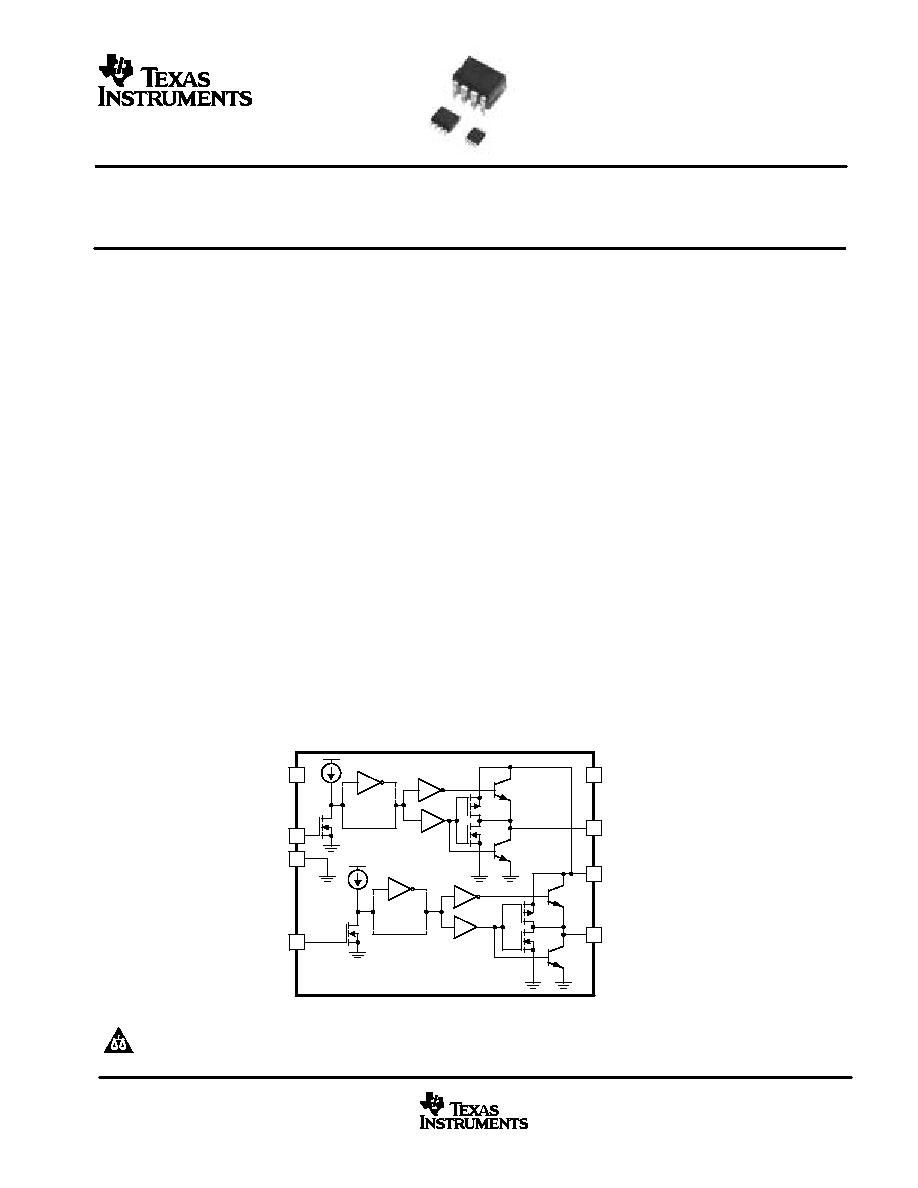
UCC27323, UCC27324, UCC27325
UCC37323, UCC37324, UCC37325
SLUS492B ≠ JUNE 2001 ≠ REVISED SEPTEMBER 2002
DUAL 4 A PEAK HIGH SPEED LOW-SIDE POWER MOSFET DRIVERS
1
www.ti.com
FEATURES
D
Industry-Standard Pin-Out
D
High Current Drive Capability of
±
4 A at the
Miller Plateau Region
D
Efficient Constant Current Sourcing Using a
Unique BiPolar & CMOS Output Stage
D
TTL/CMOS Compatible Inputs Independent of
Supply Voltage
D
20-ns Typical Rise and 15-ns Typical Fall
Times with 1.8-nF Load
D
Typical Propagation Delay Times of 25 ns with
Input Falling and 35 ns with Input Rising
D
4-V to 15-V Supply Voltage
D
Supply Current of 0.3 mA
D
Dual Outputs Can Be Paralleled for Higher
Drive Current
D
Available in Thermally Enhanced MSOP
PowerPAD
TM
Package with 4.7
∞
C/W
jc
D
Rated From ≠40
∞
C to 85
∞
C
APPLICATIONS
D
Switch Mode Power Supplies
D
DC/DC Converters
D
Motor Controllers
D
Line Drivers
DESCRIPTION
The UCC37323/4/5 family of high-speed dual MOSFET
drivers can deliver large peak currents into capacitive
loads.Three standard logic options are offered ≠
dual-inverting, dual-noninverting and one-inverting and
one-noninverting driver. The thermally enhanced 8-pin
PowerPAD
TM
MSOP package (DGN) drastically lowers
the thermal resistance to improve long-term reliability.
It is also offered in the standard SOIC-8 (D) or PDIP-8
(P) packages.
Using a design that inherently minimizes shoot-through
current, these drivers deliver 4-A of current where it is
needed most at the Miller plateau region during the
MOSFET switching transition. A unique BiPolar and
MOSFET hybrid output stage in parallel also allows
efficient current sourcing and sinking at low supply
voltages.
BLOCK DIAGRAM
1
OUTA
N/C
2
INA
3
GND
7
N/C
8
INVERTING
NON≠INVERTING
OUTB
4
5
INVERTING
NON≠INVERTING
INB
6 VDD
UDG≠01063
PowerPAD
t
is a trademark of Texas Instruments Incorporated.
PRODUCTION DATA information is current as of publication date.
Products conform to specifications per the terms of Texas Instruments
standard warranty. Production processing does not necessarily include
testing of all parameters.
Copyright
2002, Texas Instruments Incorporated
Please be aware that an important notice concerning availability, standard warranty, and use in critical applications of Texas Instruments
semiconductor products and disclaimers thereto appears at the end of this data sheet.
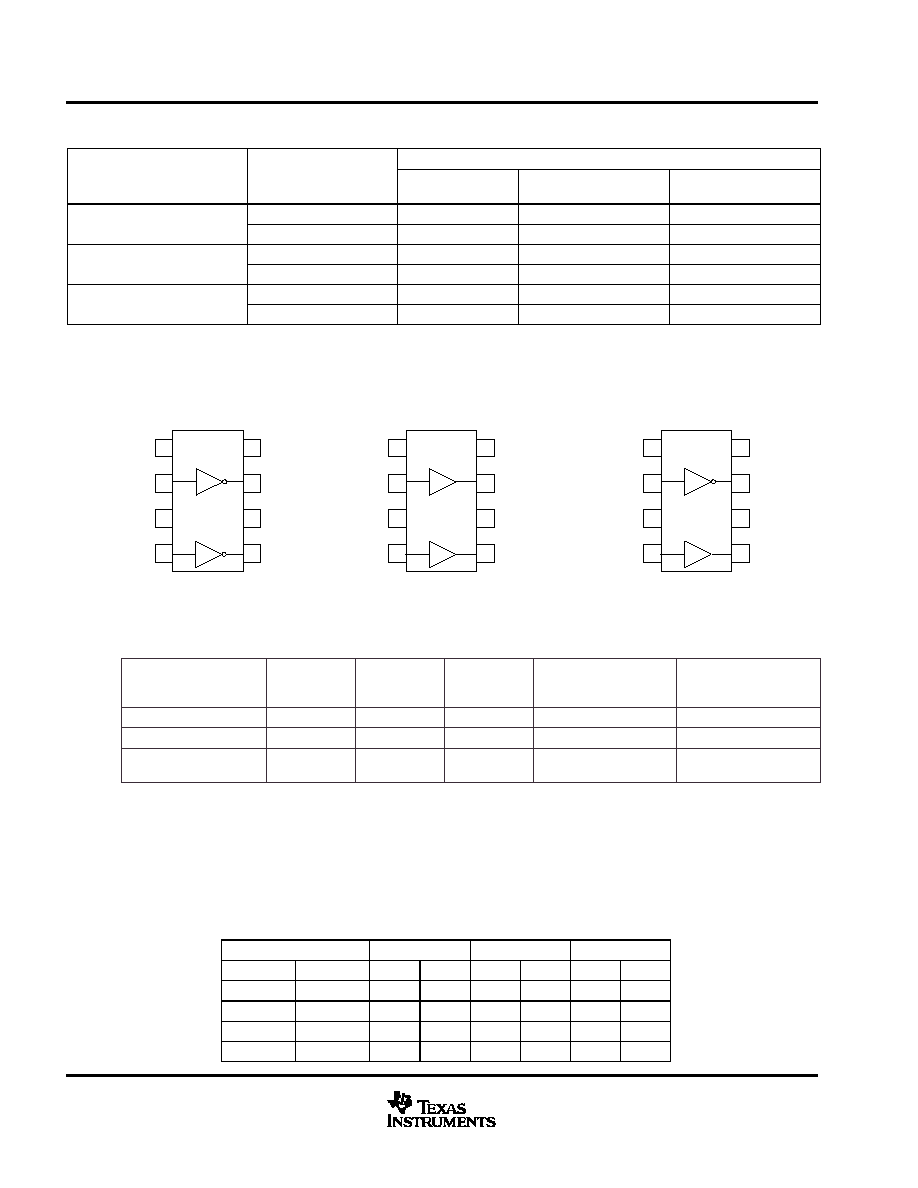
UCC27323, UCC27324, UCC27325
UCC37323, UCC37324, UCC37325
SLUS492B ≠ JUNE 2001 ≠ REVISED SEPTEMBER 2002
2
www.ti.com
ORDERING INFORMATION
OUTPUT
TEMPERATURE RANGE
PACKAGED DEVICES
OUTPUT
CONFIGURATION
TEMPERATURE RANGE
TA = TJ
SOIC-8 (D)
MSOP-8 PowerPAD
(DGN)
}
PDIP-8 (P)
Dual inverting
≠40
∞
C to +85
∞
C
UCC27323D
UCC27323DGN
UCC27323P
Dual inverting
0
∞
C to +70
∞
C
UCC37323D
UCC37323DGN
UCC37323P
D al nonIn erting
≠40
∞
C to +85
∞
C
UCC27324D
UCC27324DGN
UCC27324P
Dual nonInverting
0
∞
C to +70
∞
C
UCC37324D
UCC37324DGN
UCC37324P
One inverting,
≠40
∞
C to +85
∞
C
UCC27325D
UCC27325DGN
UCC27325P
One inverting,
one noninverting
0
∞
C to +70
∞
C
UCC37325D
UCC37325DGN
UCC37325P
D (SOIC≠8) and DGN (PowerPAD≠MSOP) packages are available taped and reeled. Add R suffix to device type (e.g. UCC27323DR,
UCC27324DGNR) to order quantities of 2,500 devices per reel for D or 1,000 devices per reel for DGN package.
The PowerPAD
is not directly connected to any leads of the package. However, it is electrically and thermally connected to the substrate which
is the ground of the device.
D, DGN, OR P PACKAGE
(TOP VIEW)
VDD
OUTA
N/A
OUTB
INA
N/A
GND
INB
1
2
3
4
8
7
6
5
D, DGN, OR P PACKAGE
(TOP VIEW)
VDD
OUTA
N/A
OUTB
INA
N/A
GND
INB
1
2
3
4
8
7
6
5
D, DGN, OR P PACKAGE
(TOP VIEW)
VDD
OUTA
N/A
OUTB
INA
N/A
GND
INB
1
2
3
4
8
7
6
5
(DUAL INVERTING)
(DUAL NONINVERTING)
(ONE INVERTING,
ONE NONINVERTING)
power dissipation rating table
PACKAGE
SUFFIX
jc (
∞
C/W)
ja (
∞
C/W)
Power Rating (mW)
TA = 70
∞
C See Note 1
Derating Factor Above
70
∞
C (mW/ C) See
Note 1
SOIC-8
D
42
84 ≠ 160
}
344≠655 See Note 2
6.25 ≠ 11.9 See Note 2
PDIP-8
P
49
110
500
9
MSOP PowerPAD-8
See Note 3
DGN
4.7
50 ≠ 59
}
1370
17.1
Notes: 1. 125
∞
C operating junction temperature is used for power rating calculations
2. The range of values indicates the effect of pc≠board. These values are intended to give the system designer an indication of the
best and worst case conditions. In general, the system designer should attempt to use larger traces on the pc≠board where possible
in order to spread the heat away form the device more effectively. For information on the PowerPAD
t
package, refer to Technical
Brief, PowerPad Thermally Enhanced Package, Texas Instrument s Literature No. SLMA002 and Application Brief, PowerPad Made
Easy, Texas Instruments Literature No. SLMA004.
3. The PowerPAD
is not directly connected to any leads of the package. However, it is electrically and thermally connected to the
substrate which is the ground of the device.
Table 1. Input/Output Table
INPUTS (VIN_L, VIN_H)
UCC37323
UCC37324
UCC37325
INA
INB
OUTA
OUTB
OUTA
OUTB
OUTA
OUTB
L
L
H
H
L
L
H
L
L
H
H
L
L
H
H
H
H
L
L
H
H
L
L
L
H
H
L
L
H
H
L
H
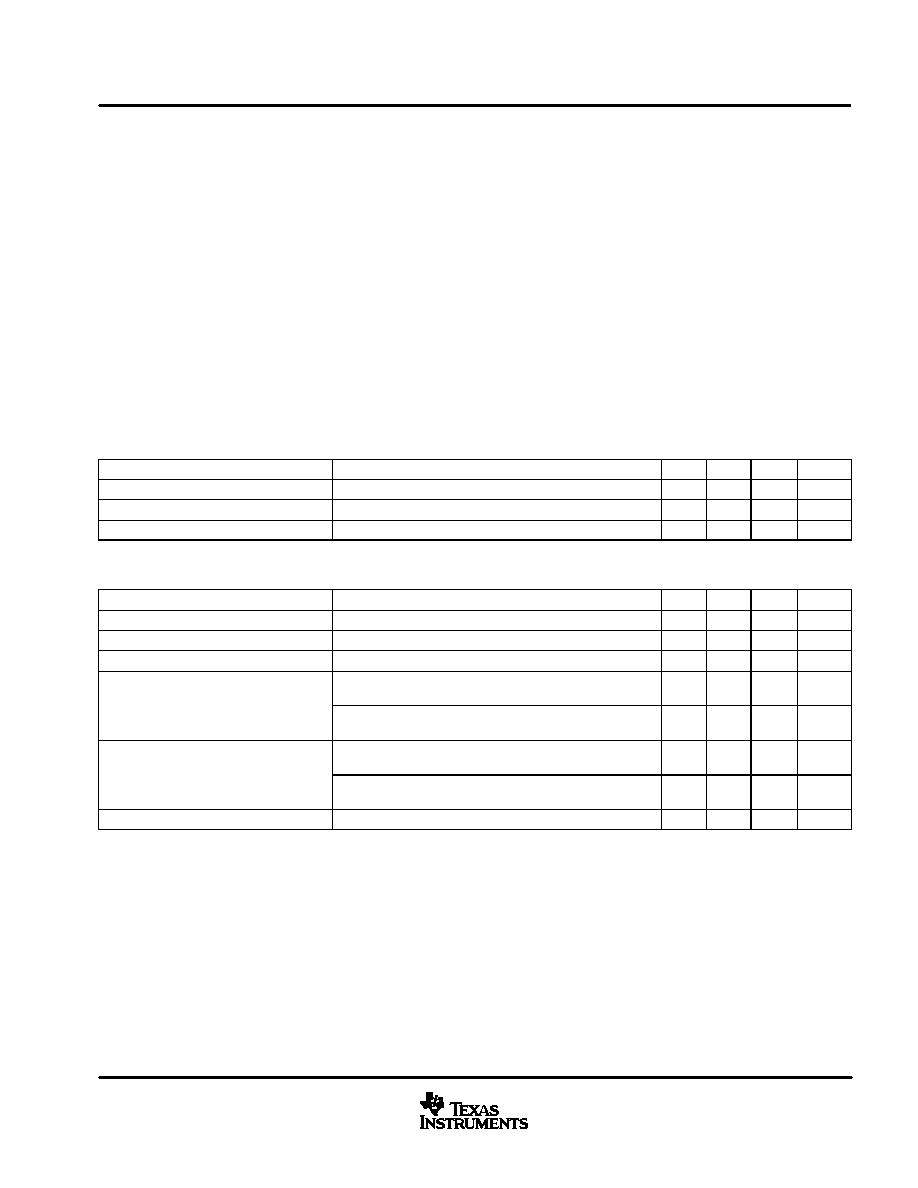
UCC27323, UCC27324, UCC27325
UCC37323, UCC37324, UCC37325
SLUS492B ≠ JUNE 2001 ≠ REVISED SEPTEMBER 2002
3
www.ti.com
absolute maximum ratings over operating free-air temperature (unless otherwise noted)
Supply voltage, V
DD
≠0.3 V to 16 V
. . . . . . . . . . . . . . . . . . . . . . . . . . . . . . . . . . . . . . . . . . . . . . . . . . . . . . . . . . . . . . . .
Output current (OUTA, OUTB) DC, I
OUT_DC
0.3 A
. . . . . . . . . . . . . . . . . . . . . . . . . . . . . . . . . . . . . . . . . . . . . . . . . .
Pulsed, (0.5
µ
s), I
OUT_PULSED
4.5 A
. . . . . . . . . . . . . . . . . . . . . . . . . . . . . . . . . .
. . .
Power dissipation at T
A
= 25
∞
C (DGN package)
3 W
. . . . . . . . . . . . . . . . . . . . . . . . . . . . . . . . . . . . . . . . . . . . . . . . .
(D package)
650 mW
. . . . . . . . . . . . . . . . . . . . . . . . . . . . . . . . . . . . . . . . . . . . . . . .
(P package)
350 mW
. . . . . . . . . . . . . . . . . . . . . . . . . . . . . . . . . . . . . . . . . . . . . . . .
Junction operating temperature, T
J
≠55
∞
C to 150
∞
C
. . . . . . . . . . . . . . . . . . . . . . . . . . . . . . . . . . . . . . . . . . . . . . . . .
Storage temperature, T
stg
≠65
∞
C to 150
∞
C
. . . . . . . . . . . . . . . . . . . . . . . . . . . . . . . . . . . . . . . . . . . . . . . . . . . . . . . . .
Lead temperature (soldering, 10 sec.),
300
∞
C
. . . . . . . . . . . . . . . . . . . . . . . . . . . . . . . . . . . . . . . . . . . . . . . . . . . . . . .
Stresses beyond those listed under "absolute maximum ratings" may cause permanent damage to the device. These are stress ratings only, and
functional operation of the device at these or any other conditions beyond those indicated under "recommended operating conditions" is not
implied. Exposure to absolute-maximum-rated conditions for extended periods may affect device reliability.
All voltages are with respect to GND. Currents are positive into, negative out of the specified terminal.
electrical characteristics, V
DD
= 4.5 V to 15 V, T
A
= T
J
, (unless otherwise noted)
input (INA, INB)
PARAMETER
TEST CONDITION
MIN
TYP
MAX
UNITS
V
IN_H
, logic 1 input threshold
2
V
V
IN_L
, logic 0 input threshold
1
V
Input current
0 V <= V
IN
<= V
DD
≠10
0
10
µ
A
output (OUTA, OUTB)
PARAMETER
TEST CONDITION
MIN
TYP
MAX
UNITS
Output current
VDD = 14 V,
See Note 1,
See Note 2
4
A
VOH, high-level output voltage
V
OH
= V
DD
≠ V
OUT
,
I
OUT
= ≠10 mA
300
450
mV
VOL, low-level output level
I
OUT
= 10 mA
22
40
mV
Output resistance high
TA = 25
∞
C, I
OUT
= ≠10 mA,
V
DD
= 14 V,
See Note 3
25
30
35
TA = full range,
I
OUT
= ≠10 mA,
V
DD
= 14 V,
See Note 3
18
42
Output resistance low
TA = 25
∞
C,
I
OUT
= 10 mA,
V
DD
= 14 V,
See Note 3
1.9
2.2
2.5
TA = full range
I
OUT
= 10 mA,
V
DD
= 14 V,
See Note 3
1.2
4.0
Latch-up protection
See Note 1
500
mA
NOTES:
1. Ensured by design. Not tested in production.
2. The pullup / pulldown circuits of the driver are bipolar and MOSFET transistors in parallel. The pulsed output current rating is the
combined current from the bipolar and MOSFET transistors.
3. The pullup / pulldown circuits of the driver are bipolar and MOSFET transistors in parallel. The output resistance is the R
DS(ON)
of
the MOSFET transistor when the voltage on the driver output is less than the saturation voltage of the bipolar transistor.
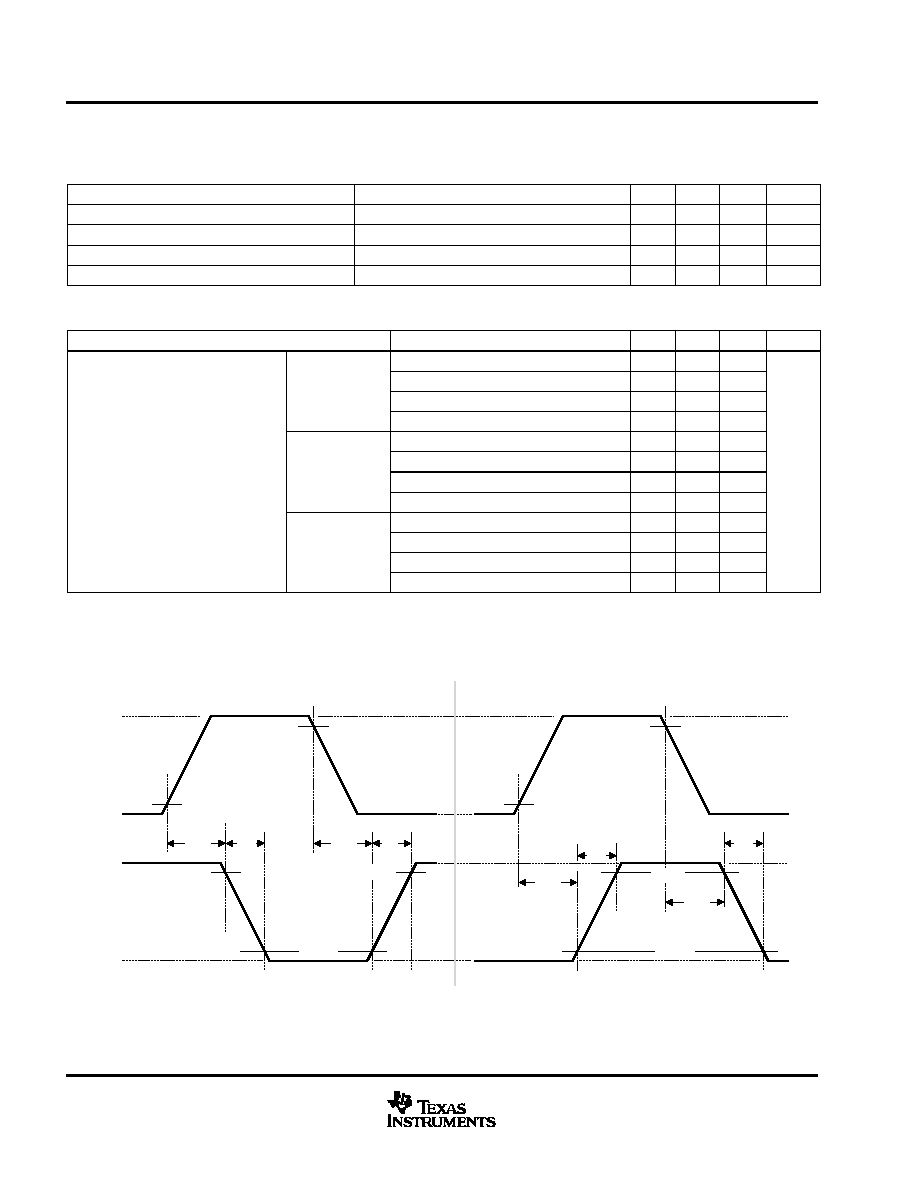
UCC27323, UCC27324, UCC27325
UCC37323, UCC37324, UCC37325
SLUS492B ≠ JUNE 2001 ≠ REVISED SEPTEMBER 2002
4
www.ti.com
electrical characteristics, V
DD
= 4.5 V to 15 V, T
A
= T
J
, (unless otherwise noted)
switching time
PARAMETER
TEST CONDITION
MIN
TYP
MAX
UNITS
t
R
, rise time (OUTA, OUTB)
C
LOAD
= 1.8 nF,
See Figure 1
20
40
ns
t
F
, fall time (OUTA, OUTB)
C
LOAD
= 1.8 nF,
See Figure 1
15
40
ns
t
D1
, delay, IN rising (IN to OUT)
C
LOAD
= 1.8 nF,
See Figure 1
25
40
ns
t
D2
, delay, IN falling (IN to OUT)
C
LOAD
= 1.8 nF,
See Figure 1
35
50
ns
overall
PARAMETER
TEST CONDITION
MIN
TYP
MAX
UNITS
INA = 0 V,
INB = 0 V
300
450
UCCx7323
INA = 0 V,
INB = HIGH
300
450
UCCx7323
INA = HIGH,
INB = 0 V
300
450
INA = HIGH,
INB = HIGH
300
450
INA = 0 V,
INB = 0 V
2
50
I
static operating c rrent
UCC 7324
INA = 0 V,
INB = HIGH
300
450
A
IDD, static operating current
UCCx7324
INA = HIGH,
INB = 0 V
300
450
µ
A
INA = HIGH,
INB = HIGH
600
750
INA = 0 V,
INB = 0 V
150
300
UCC 7325
INA = 0 V,
INB = HIGH
450
600
UCCx7325
INA = HIGH,
INB = 0 V
150
300
INA = HIGH,
INB = HIGH
450
600
NOTES:
1. Ensured by design. Not production.
2. The pullup / pulldown circuits of the driver are bipolar and MOSFET transistors in parallel. The peak output current rating is the
combined current from the bipolar and MOSFET transistors.
3. The pullup / pulldown circuits of the driver are bipolar and MOSFET transistors in parallel. The output resistance is the R
DS(ON)
of
the MOSFET transistor when the voltage on the driver output is less than the saturation voltage of the bipolar transistor.
+5V
INPUT
16V
OUTPUT
0V
0V
10%
90%
10%
90%
(a)
90%
90%
10%
90%
(b)
INPUT
OUTPUT
10%
tD1
tD2
tF
tf
tD1
tF
tF
tD2
Figure 1. Switching Waveforms for (a) Inverting Driver and (b) Noninverting Driver

UCC27323, UCC27324, UCC27325
UCC37323, UCC37324, UCC37325
SLUS492B ≠ JUNE 2001 ≠ REVISED SEPTEMBER 2002
5
www.ti.com
Terminal Functions
TERMINAL
FUNCTION
NO.
NAME
I/O
FUNCTION
1
N/C
≠
No connection. Should be grounded.
2
INA
I
Input A. Input signal of the A driver which has logic compatible threshold and hysteresis.
If not used, this input should be tied to either VDD or GND. It should not be left floating.
3
GND
≠
Common ground. This ground should be connected very closely to the source of the
power MOSFET which the driver is driving.
4
INB
I
Input B. Input signal of the A driver which has logic compatible threshold and hysteresis.
If not used, this input should be tied to either VDD or GND. It should not be left floating.
5
OUTB
O
Driver output B. The output stage is capable of providing 4-A drive current to the gate of
a power MOSFET.
6
VDD
I
Supply. Supply voltage and the power input connection for this device.
7
OUTA
O
Driver output A. The output stage is capable of providing 4-A drive current to the gate of
a power MOSFET.
8
N/C
≠
No Connection. Should be grounded.
APPLICATION INFORMATION
general information
High frequency power supplies often require high-speed, high-current drivers such as the UCC37323/4/5 family.
A leading application is the need to provide a high power buffer stage between the PWM output of the control
IC and the gates of the primary power MOSFET or IGBT switching devices. In other cases, the driver IC is
utilized to drive the power device gates through a drive transformer. Synchronous rectification supplies also
have the need to simultaneously drive multiple devices which can present an extremely large load to the control
circuitry.
Driver ICs are utilized when it is not feasible to have the primary PWM regulator IC directly drive the switching
devices for one or more reasons. The PWM IC may not have the brute drive capability required for the intended
switching MOSFET, limiting the switching performance in the application. In other cases there may be a desire
to minimize the effect of high frequency switching noise by placing the high current driver physically close to
the load. Also, newer ICs that target the highest operating frequencies may not incorporate onboard gate drivers
at all. Their PWM outputs are only intended to drive the high impedance input to a driver such as the
UCC37323/4/5. Finally, the control IC may be under thermal stress due to power dissipation, and an external
driver can help by moving the heat from the controller to an external package.

UCC27323, UCC27324, UCC27325
UCC37323, UCC37324, UCC37325
SLUS492B ≠ JUNE 2001 ≠ REVISED SEPTEMBER 2002
6
www.ti.com
APPLICATION INFORMATION
input stage
The inputs of UCC37323/4/5 family of drivers are designed to withstand 500-mA reverse current without either
damage to the IC for logic upset. The input stage of each driver should be driven by a signal with a short rise
or fall time. This condition is satisfied in typical power supply applications, where the input signals are provided
by a PWM controller or logic gates with fast transition times (<200 ns). The input stages to the drivers function
as a digital gate, and they are not intended for applications where a slow changing input voltage is used to
generate a switching output when the logic threshold of the input section is reached. While this may not be
harmful to the driver, the output of the driver may switch repeatedly at a high frequency.
Users should not attempt to shape the input signals to the driver in an attempt to slow down (or delay) the signal
at the output. If limiting the rise or fall times to the power device is desired, limit the rise or fall times to the power
device, then an external resistance can be added between the output of the driver and the load device, which
is generally a power MOSFET gate. The external resistor may also help remove power dissipation from the IC
package, as discussed in the section on Thermal Considerations.
output stage
Inverting outputs of the UCC37323 and OUTA of the UCC37325 are intended to drive external P-channel
MOSFETs. Noninverting outputs of the UCC37324 and OUTB of the UCC37325 are intended to drive external
N-channel MOSFETs.
Each output stage is capable of supplying
±
4-A peak current pulses and swings to both VDD and GND. The
pullup/ pulldown circuits of the driver are constructed of bipolar and MOSFET transistors in parallel. The peak
output current rating is the combined current from the bipolar and MOSFET transistors. The output resistance
is the R
DS(on)
of the MOSFET transistor when the voltage on the driver output is less than the saturation voltage
of the bipolar transistor. Each output stage also provides a very low impedance to overshoot and undershoot
due to the body diode of the external MOSFET. This means that in many cases, external-schottky-clamp diodes
are not required.
The UCC37323 family delivers 4-A of gate drive where it is most needed during the MOSFET switching
transition ≠ at the Miller plateau region ≠ providing improved efficiency gains. A unique BiPolar and MOSFET
hybrid output stage in parallel also allows efficient current sourcing at low supply voltages.
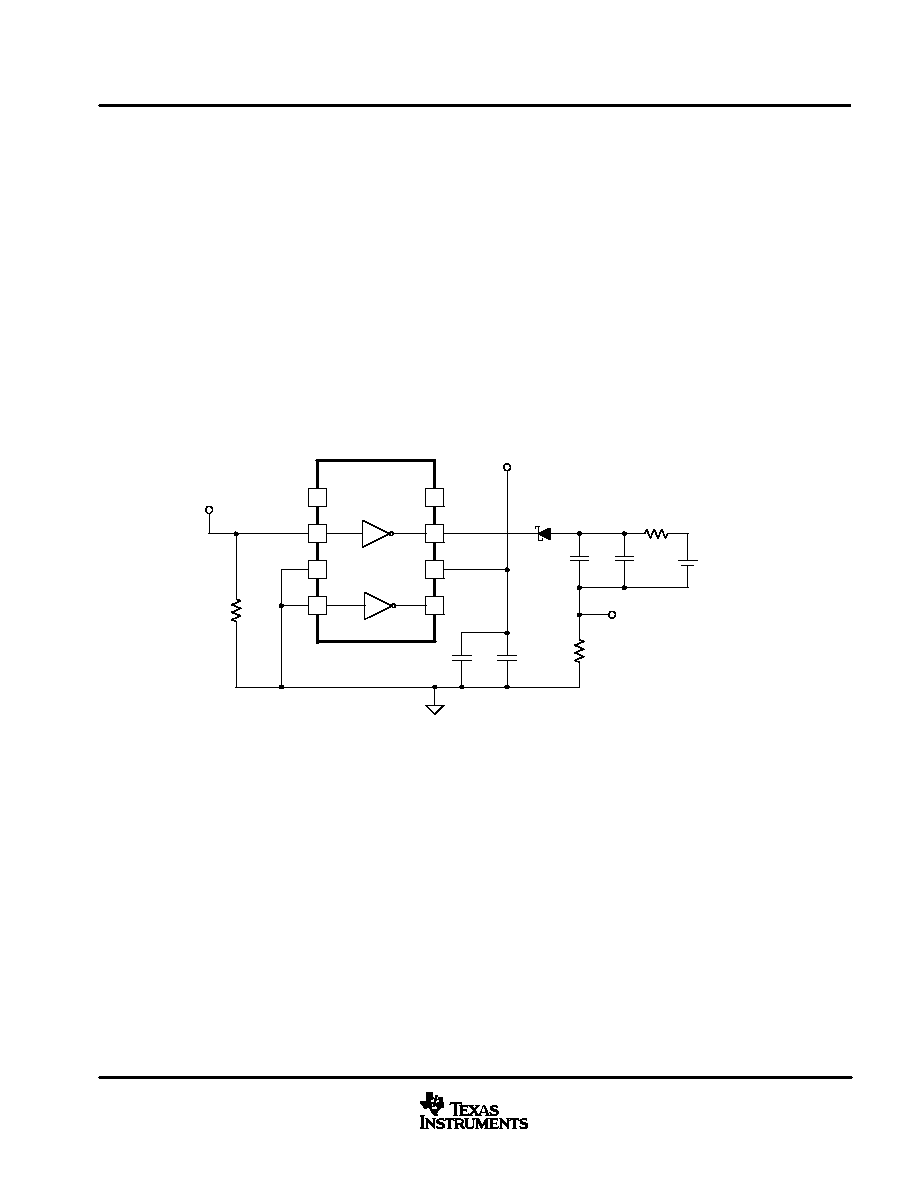
UCC27323, UCC27324, UCC27325
UCC37323, UCC37324, UCC37325
SLUS492B ≠ JUNE 2001 ≠ REVISED SEPTEMBER 2002
7
www.ti.com
APPLICATION INFORMATION
source/sink capabilities during Miller plateau
Large power MOSFETs present a large load to the control circuitry. Proper drive is required for efficient, reliable
operation. The UCC37323/4/5 drivers have been optimized to provide maximum drive to a power MOSFET
during the Miller plateau region of the switching transition. This interval occurs while the drain voltage is swinging
between the voltage levels dictated by the power topology, requiring the charging/discharging of the drain-gate
capacitance with current supplied or removed by the driver IC. [1]
Two circuits are used to test the current capabilities of the UCC37323 driver. In each case external circuitry is
added to clamp the output near 5 V while the IC is sinking or sourcing current. An input pulse of 250 ns is applied
at a frequency of 1 kHz in the proper polarity for the respective test. In each test there is a transient period where
the current peaked up and then settled down to a steady-state value. The noted current measurements are
made at a time of 200 ns after the input pulse is applied, after the initial transient.
The first circuit in Figure 2 is used to verify the current sink capability when the output of the driver is clamped
around 5 V, a typical value of gate-source voltage during the Miller plateau region. The UCC37323 is found to
sink 4.5 A at V
DD
= 15 V and 4.28 A at V
DD
= 12 V.
UDG≠01065
UCC37323
GND
1
2
3
4
INB
INA
7
6
5
8
OUTA
VDD
OUTB
INPUT
1
µ
F
CER
100
µ
F
AL EL
DSCHOTTKY
VDD
C2
1
µ
F
VSNS
RSNS
0.1
C3
100
µ
F
10
+
VSUPPLY
5.5 V
Figure 2.

UCC27323, UCC27324, UCC27325
UCC37323, UCC37324, UCC37325
SLUS492B ≠ JUNE 2001 ≠ REVISED SEPTEMBER 2002
8
www.ti.com
APPLICATION INFORMATION
The circuit shown in Figure 3 is used to test the current source capability with the output clamped to around 5 V
with a string of Zener diodes. The UCC37323 is found to source 4.8 A at V
DD
= 15 V and 3.7 A at V
DD
= 12 V.
UCC37323
GND
1
2
3
4
INB
INA
7
6
5
8
OUTA
VDD
OUTB
INPUT
1
µ
F
CER
100
µ
F
AL EL
DSCHOTTKY
VDD
C2
1
µ
F
VSNS
RSNS
0.1
C3
100
µ
F
10
DADJ
4.5 V
UDG≠01066
Figure 3.
It should be noted that the current sink capability is slightly stronger than the current source capability at lower
VDD. This is due to the differences in the structure of the bipolar-MOSFET power output section, where the
current source is a P-channel MOSFET and the current sink has an N-channel MOSFET.
In a large majority of applications it is advantageous that the turn-off capability of a driver is stronger than the
turn-on capability. This helps to ensure that the MOSFET is held OFF during common power supply transients
which may turn the device back ON.
parallel outputs
The A and B drivers may be combined into a single driver by connecting the INA/INB inputs together and the
OUTA/OUTB outputs together. Then, a single signal can control the paralleled combination as shown in
Figure 4.
UDG≠01067
UCC37323
GND
1
2
3
4
INB
INA
7
6
5
8
OUTA
VDD
OUTB
INPUT
0.1
µ
F
CER
2.2
µ
F
VDD = 12 V
CLOAD
Figure 4.
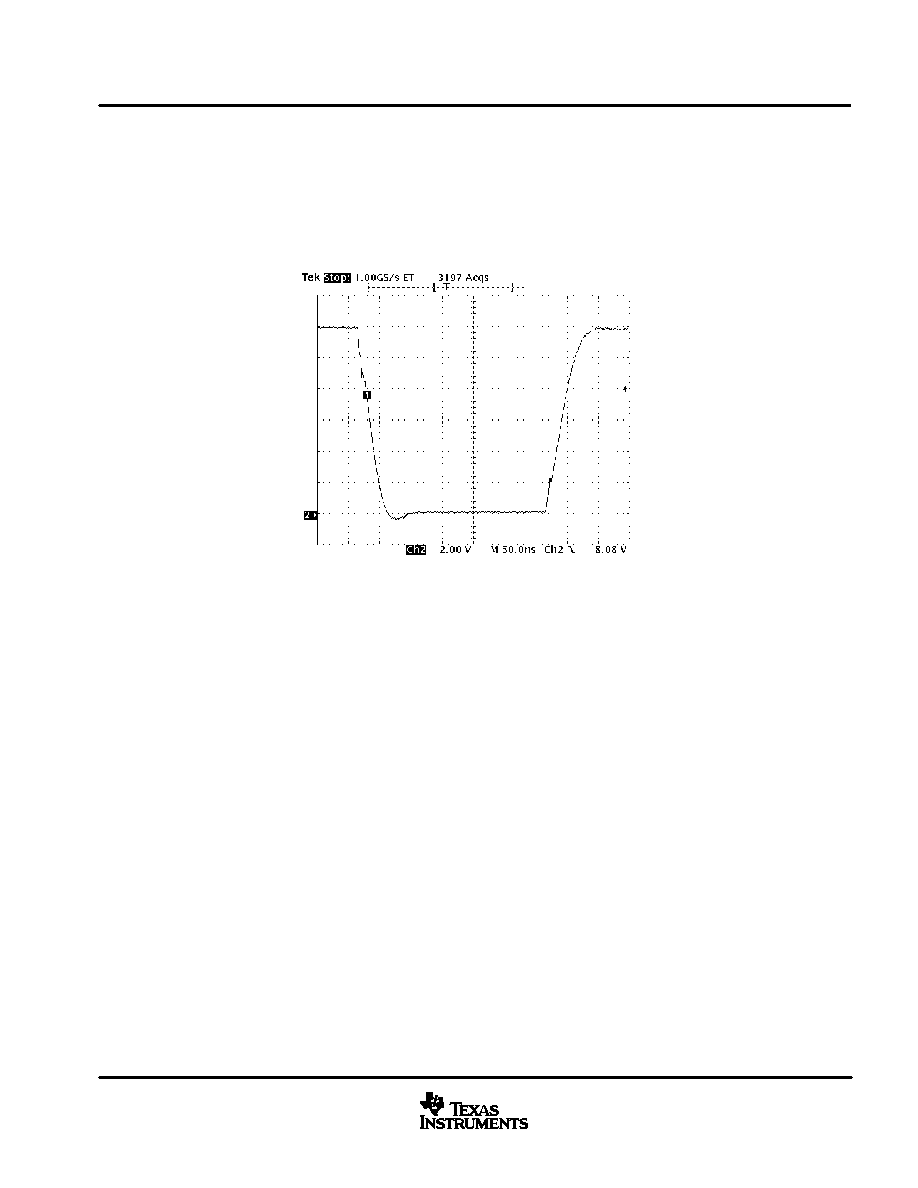
UCC27323, UCC27324, UCC27325
UCC37323, UCC37324, UCC37325
SLUS492B ≠ JUNE 2001 ≠ REVISED SEPTEMBER 2002
9
www.ti.com
APPLICATION INFORMATION
operational waveforms and circuit layout
Figure 5 shows the circuit performance achievable with a single driver (1/2 of the 8-pin IC) driving a 10-nF load.
The input pulsewidth (not shown) is set to 300 ns to show both transitions in the output waveform. Note the linear
rise and fall edges of the switching waveforms. This is due to the constant output current characteristic of the
driver as opposed to the resistive output impedance of traditional MOSFET-based gate drivers.
Figure 5.
In a power driver operating at high frequency, it is a significant challenge to get clean waveforms without much
overshoot/undershoot and ringing. The low output impedance of these drivers produces waveforms with high
di/dt. This tends to induce ringing in the parasitic inductances. Utmost care must be used in the circuit layout.
It is advantageous to connect the driver IC as close as possible to the leads. The driver IC layout has ground
on the opposite side of the output, so the ground should be connected to the bypass capacitors and the load
with copper trace as wide as possible. These connections should also be made with a small enclosed loop area
to minimize the inductance.
VDD
Although quiescent VDD current is very low, total supply current will be higher, depending on OUTA and OUTB
current and the programmed oscillator frequency. Total VDD current is the sum of quiescent VDD current and
the average OUT current. Knowing the operating frequency and the MOSFET gate charge (Qg), average OUT
current can be calculated from:
I
OUT
= Qg x f, where f is frequency
For the best high-speed circuit performance, two V
DD
bypass capacitors are recommended tp prevent noise
problems. The use of surface mount components is highly recommended. A 0.1-
µ
F ceramic capacitor should
be located closest to the VDD to ground connection. In addition, a larger capacitor (such as 1-
µ
F) with relatively
low ESR should be connected in parallel, to help deliver the high current peaks to the load. The parallel
combination of capacitors should present a low impedance characteristic for the expected current levels in the
driver application.

UCC27323, UCC27324, UCC27325
UCC37323, UCC37324, UCC37325
SLUS492B ≠ JUNE 2001 ≠ REVISED SEPTEMBER 2002
10
www.ti.com
APPLICATION INFORMATION
drive current and power requirements
The UCC37323/4/5 family of drivers are capable of delivering 4-A of current to a MOSFET gate for a period of
several hundred nanoseconds. High peak current is required to turn the device ON quickly. Then, to turn the
device OFF, the driver is required to sink a similar amount of current to ground. This repeats at the operating
frequency of the power device. A MOSFET is used in this discussion because it is the most common type of
switching device used in high frequency power conversion equipment.
References 1 and 2 discuss the current required to drive a power MOSFET and other capacitive-input switching
devices. Reference 2 includes information on the previous generation of bipolar IC gate drivers.
When a driver IC is tested with a discrete, capacitive load it is a fairly simple matter to calculate the power that
is required from the bias supply. The energy that must be transferred from the bias supply to charge the capacitor
is given by:
E
+
1
2
CV2, where C is the load capacitor and V is the bias voltage feeding the driver.
There is an equal amount of energy transferred to ground when the capacitor is discharged. This leads to a
power loss given by the following:
P
+
2
1
2
CV2f, where f is the switching frequency.
This power is dissipated in the resistive elements of the circuit. Thus, with no external resistor between the driver
and gate, this power is dissipated inside the driver. Half of the total power is dissipated when the capacitor is
charged, and the other half is dissipated when the capacitor is discharged. An actual example using the
conditions of the previous gate drive waveform should help clarify this.
With V
DD
= 12 V, C
LOAD
= 10 nF, and f = 300 kHz, the power loss can be calculated as:
P = 10 nF x (12)
2
x (300 kHz) = 0.432 W
With a 12-V supply, this would equate to a current of:
I
+
P
V
+
0.432 W
12 V
+
0.036 A
The actual current measured from the supply was 0.037 A, and is very close to the predicted value. But, the
I
DD
current that is due to the IC internal consumption should be considered. With no load the IC current draw
is 0.0027 A. Under this condition the output rise and fall times are faster than with a load. This could lead to an
almost insignificant, yet measurable current due to cross-conduction in the output stages of the driver. However,
these small current differences are buried in the high frequency switching spikes, and are beyond the
measurement capabilities of a basic lab setup. The measured current with 10-nF load is reasonably close to
that expected.

UCC27323, UCC27324, UCC27325
UCC37323, UCC37324, UCC37325
SLUS492B ≠ JUNE 2001 ≠ REVISED SEPTEMBER 2002
11
www.ti.com
APPLICATION INFORMATION
The switching load presented by a power MOSFET can be converted to an equivalent capacitance by examining
the gate charge required to switch the device. This gate charge includes the effects of the input capacitance
plus the added charge needed to swing the drain of the device between the ON and OFF states. Most
manufacturers provide specifications that provide the typical and maximum gate charge, in nC, to switch the
device under specified conditions. Using the gate charge Qg, one can determine the power that must be
dissipated when charging a capacitor. This is done by using the equivalence Qg = CeffV to provide the following
equation for power:
P
+
C
V2
f
+
Qg
f
This equation allows a power designer to calculate the bias power required to drive a specific MOSFET gate
at a specific bias voltage.
THERMAL INFORMATION
The useful range of a driver is greatly affected by the drive power requirements of the load and the thermal
characteristics of the IC package. In order for a power driver to be useful over a particular temperature range
the package must allow for the efficient removal of the heat produced while keeping the junction temperature
within rated limits. The UCC37323/4/5 family of drivers is available in three different packages to cover a range
of application requirements.
As shown in the power dissipation rating table, the SOIC-8 (D) and PDIP-8 (P) packages each have a power
rating of around 0.5 W with T
A
= 70
∞
C. This limit is imposed in conjunction with the power derating factor also
given in the table. Note that the power dissipation in our earlier example is 0.432 W with a 10-nF load, 12 VDD,
switched at 300 kHz. Thus, only one load of this size could be driven using the D or P package, even if the two
onboard drivers are paralleled. The difficulties with heat removal limit the drive available in the older packages.
The MSOP PowerPAD-8 (DGN) package significantly relieves this concern by offering an effective means of
removing the heat from the semiconductor junction. As illustrated in Reference 2, the PowerPAD packages offer
a leadframe die pad that is exposed at the base of the package. This pad is soldered to the copper on the PC
board directly underneath the IC package, reducing the
jc down to 4.7
∞
C/W. Data is presented in Reference 2
to show that the power dissipation can be quadrupled in the PowerPAD configuration when compared to the
standard packages. The PC board must be designed with thermal lands and thermal vias to complete the heat
removal subsystem, as summarized in Reference 3. This allows a significant improvement in heatsinking over
that available in the D or P packages, and is shown to more than double the power capability of the D and P
packages.
references
1.
Power Supply Seminar SEM≠1400 Topic 2: Design And Application Guide For High Speed MOSFET
Gate Drive Circuits, by Laszlo Balogh, Texas Instruments Literature No. SLUP133.
2.
Application Note, Practical Considerations in High Performance MOSFET, IGBT and MCT Gate Drive
Circuits, by Bill Andreycak, Texas Instruments Literature No. SLUA105
3.
Technical Brief, PowerPad Thermally Enhanced Package, Texas Instruments Literature No. SLMA002
4.
Application Brief, PowerPAD Made Easy, Texas Instruments Literature No. SLMA004

UCC27323, UCC27324, UCC27325
UCC37323, UCC37324, UCC37325
SLUS492B ≠ JUNE 2001 ≠ REVISED SEPTEMBER 2002
12
www.ti.com
MECHANICAL DATA
D (R-PDSO-G**)
PLASTIC SMALL-OUTLINE PACKAGE
8 PINS SHOWN
8
0.197
(5,00)
A MAX
A MIN
(4,80)
0.189
0.337
(8,55)
(8,75)
0.344
14
0.386
(9,80)
(10,00)
0.394
16
DIM
PINS **
4040047/E 09/01
0.069 (1,75) MAX
Seating Plane
0.004 (0,10)
0.010 (0,25)
0.010 (0,25)
0.016 (0,40)
0.044 (1,12)
0.244 (6,20)
0.228 (5,80)
0.020 (0,51)
0.014 (0,35)
1
4
8
5
0.150 (3,81)
0.157 (4,00)
0.008 (0,20) NOM
0
∞
≠ 8
∞
Gage Plane
A
0.004 (0,10)
0.010 (0,25)
0.050 (1,27)
NOTES: A. All linear dimensions are in inches (millimeters).
B. This drawing is subject to change without notice.
C. Body dimensions do not include mold flash or protrusion, not to exceed 0.006 (0,15).
D. Falls within JEDEC MS-012
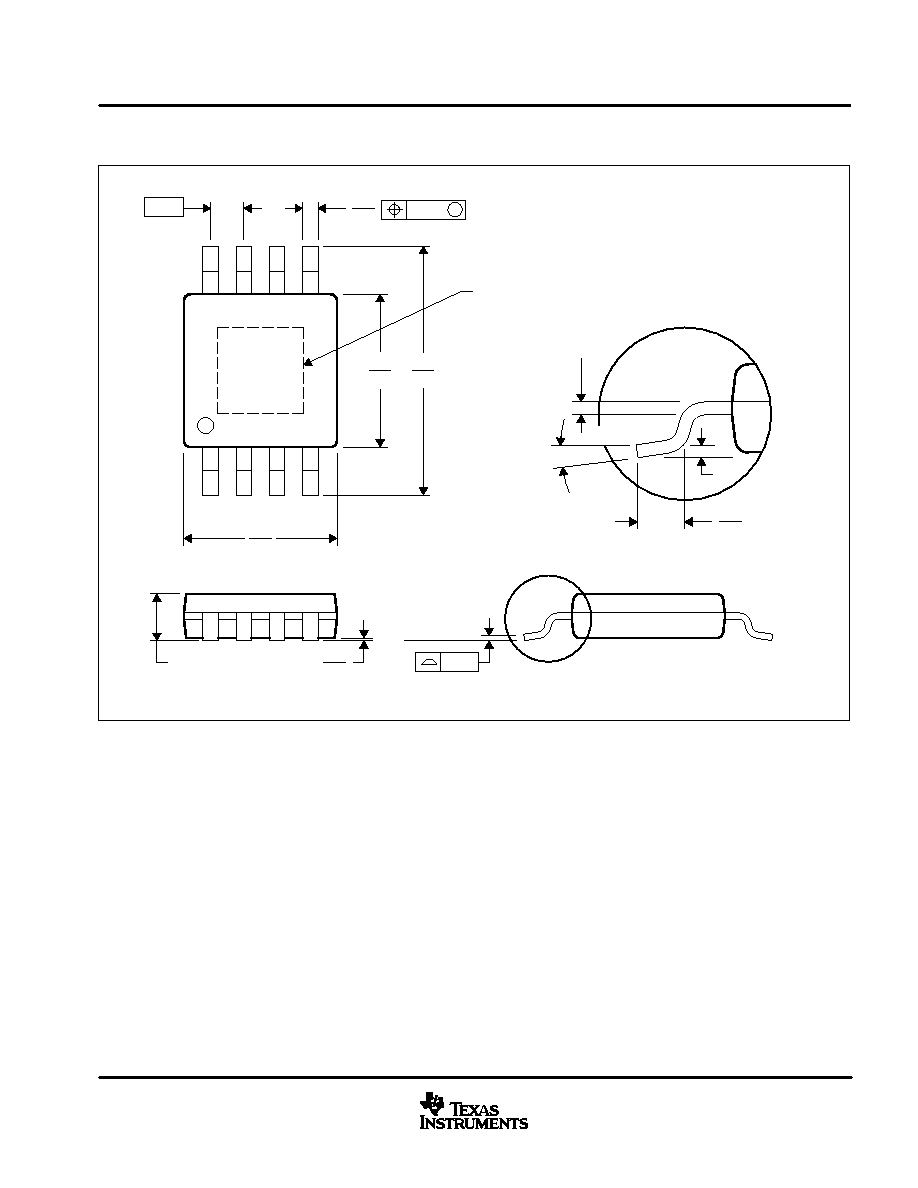
UCC27323, UCC27324, UCC27325
UCC37323, UCC37324, UCC37325
SLUS492B ≠ JUNE 2001 ≠ REVISED SEPTEMBER 2002
13
www.ti.com
MECHANICAL DATA
DGN (MSOP)
PowerPAD
PLASTIC SMALL-OUTLINE PACKAGE
0,69
0,41
0,25
Thermal Pad
(See Note F)
0,15 NOM
Gage Plane
4073271/A 04/98
4,98
0,25
5
3,05
4,78
2,95
8
4
3,05
2,95
1
0,38
0,15
0,05
1,07 MAX
Seating Plane
0,10
0,65
M
0,25
0
∞
≠6
∞
NOTES: A. All linear dimensions are in millimeters.
B. This drawing is subject to change without notice.
C. Body dimensions include mold flash or protrusions.
D. Falls within JEDEC MO-187
E.
The package thermal performance may be enhanced by attaching an external heat sink to the thermal pad.
F.
The PowerPAD
is not directly connected to any leads of the package. However, it is electrically and thermally connected to the
substrate which is the ground of the device. The exposed pad dimension is 1.3 mm x 1.7 mm. However, the tolerances can be
+1.05/≠0.05 mm (+ 41 / ≠2 mils) due to position and mold flow variation.
G.
For additional information on the PowerPAD
t
package and how to take advantage of its heat dissipating abilities, refer to Technical
Brief, PowerPad Thermally Enhanced Package, Texas Instrument s Literature No. SLMA002 and Application Brief, PowerPad Made
Easy, Texas Instruments Literature No. SLMA004. Both documents are available at www.ti.com.
PowerPAD
t
is a trademark of Texas Instruments Incorporated.
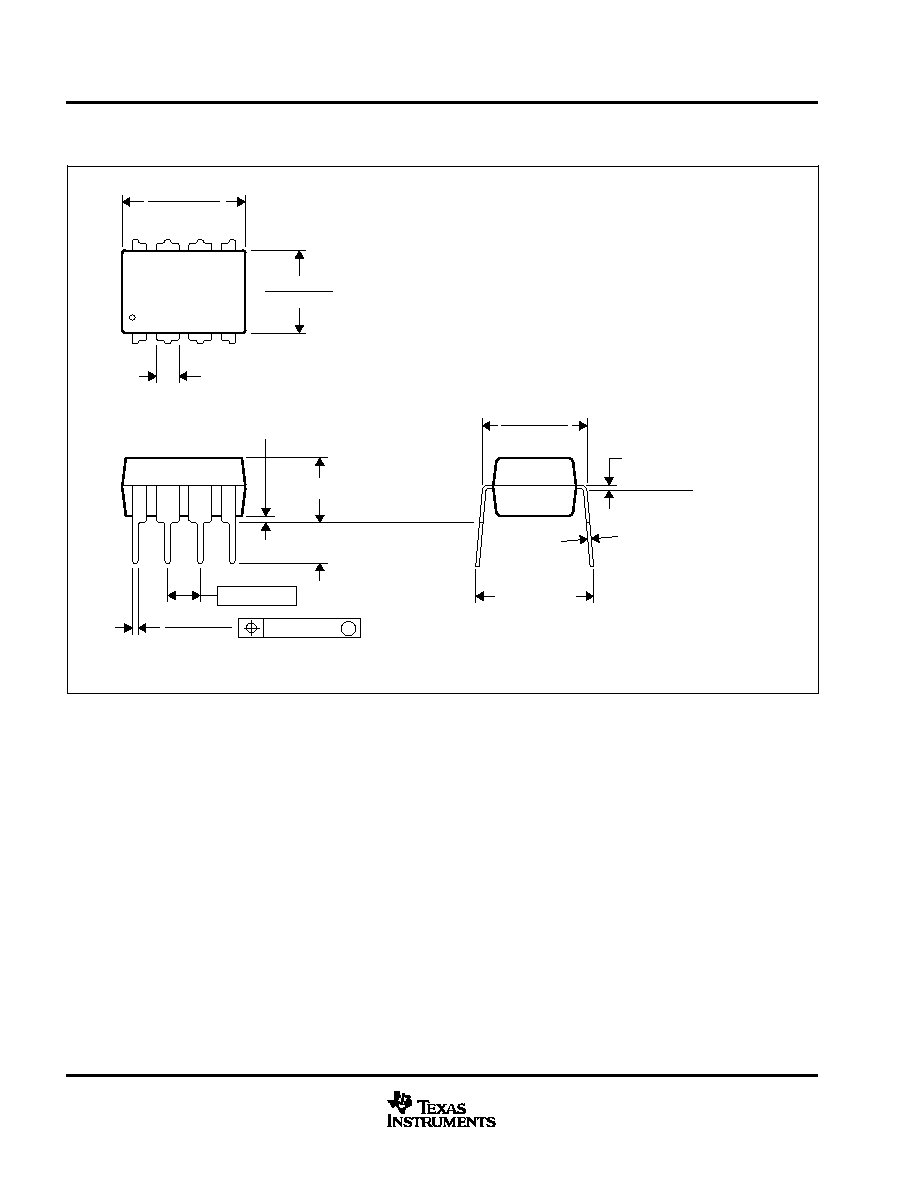
UCC27323, UCC27324, UCC27325
UCC37323, UCC37324, UCC37325
SLUS492B ≠ JUNE 2001 ≠ REVISED SEPTEMBER 2002
14
www.ti.com
MECHANICAL DATA
P (PDIP)
PLASTIC DUAL-IN-LINE
8
4
0.015 (0,38)
Gage Plane
0.325 (8,26)
0.300 (7,62)
0.010 (0,25) NOM
MAX
0.430 (10,92)
4040082/D 05/98
0.200 (5,08) MAX
0.125 (3,18) MIN
5
0.355 (9,02)
0.020 (0,51) MIN
0.070 (1,78) MAX
0.240 (6,10)
0.260 (6,60)
0.400 (10,60)
1
0.015 (0,38)
0.021 (0,53)
Seating Plane
M
0.010 (0,25)
0.100 (2,54)
NOTES: A. All linear dimensions are in inches (millimeters).
B. This drawing is subject to change without notice.
C. Falls within JEDEC MS-001
For the latest package information, go to http://www.ti.com/sc/docs/package/pkg_info.htm

IMPORTANT NOTICE
Texas Instruments Incorporated and its subsidiaries (TI) reserve the right to make corrections, modifications,
enhancements, improvements, and other changes to its products and services at any time and to discontinue
any product or service without notice. Customers should obtain the latest relevant information before placing
orders and should verify that such information is current and complete. All products are sold subject to TI's terms
and conditions of sale supplied at the time of order acknowledgment.
TI warrants performance of its hardware products to the specifications applicable at the time of sale in
accordance with TI's standard warranty. Testing and other quality control techniques are used to the extent TI
deems necessary to support this warranty. Except where mandated by government requirements, testing of all
parameters of each product is not necessarily performed.
TI assumes no liability for applications assistance or customer product design. Customers are responsible for
their products and applications using TI components. To minimize the risks associated with customer products
and applications, customers should provide adequate design and operating safeguards.
TI does not warrant or represent that any license, either express or implied, is granted under any TI patent right,
copyright, mask work right, or other TI intellectual property right relating to any combination, machine, or process
in which TI products or services are used. Information published by TI regarding third≠party products or services
does not constitute a license from TI to use such products or services or a warranty or endorsement thereof.
Use of such information may require a license from a third party under the patents or other intellectual property
of the third party, or a license from TI under the patents or other intellectual property of TI.
Reproduction of information in TI data books or data sheets is permissible only if reproduction is without
alteration and is accompanied by all associated warranties, conditions, limitations, and notices. Reproduction
of this information with alteration is an unfair and deceptive business practice. TI is not responsible or liable for
such altered documentation.
Resale of TI products or services with statements different from or beyond the parameters stated by TI for that
product or service voids all express and any implied warranties for the associated TI product or service and
is an unfair and deceptive business practice. TI is not responsible or liable for any such statements.
Mailing Address:
Texas Instruments
Post Office Box 655303
Dallas, Texas 75265
Copyright
2002, Texas Instruments Incorporated














